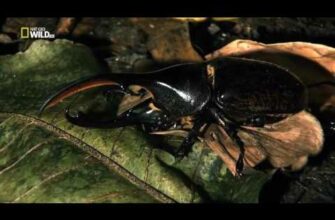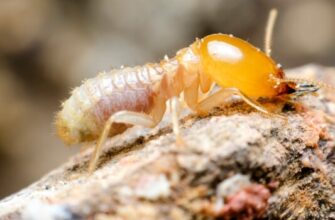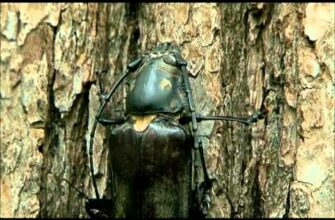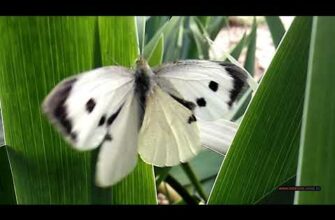A curious little insect that, on the one hand, can be unpleasant to the human eye, but on the other hand, delight our ears with its melodic sound. When we walk in a park or a forest clearing in warm and dry summer weather, we hear hundreds of unusual “bugs” emitting sounds with different timbres and frequency, bearing the proud name of a cricket.
View origin and description
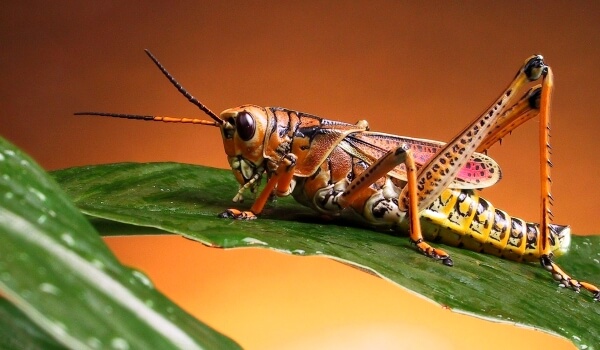
Photo: Cricket
In our nature, there are several species of crickets from the family of “true crickets”, the Latin name of which is Gryllidae:
- Far Eastern stem cricket (Oecanthus longicaudus) — they can be found in Japan, China and the Russian Far East. The second name of the insect is “eastern trumpet”.
- Field cricket (Gryllus campestris) is a species of orthoptera crickets. They are found more often in the countries of Asia Minor and Western, Southern and Central Europe, and in African countries. They prefer mostly sunny meadows and fields, open places under the sun, light pine forests, any open spaces under the sun.
- The house cricket (Acheta domesticus) – like the field cricket, belongs to the species of straight-winged crickets. This insect settles in the cold period of time in human dwellings, in any warm rooms, heated industrial buildings, basements, etc. With the onset of warm spring and until the warmest autumn, they leave the premises, and other outbuildings, into nature. The second name is home cricket.
There are also ant crickets, otherwise they are also called “ant-loving ordinary.” It belongs to the order of orthopteran insects and the type of small ant crickets. In another way, they are also called ant-loving cricket. Small and wingless insects. They are considered the smallest of all cricket insects. The closest “relatives” to the cricket — grasshoppers and locusts.
Appearance and Features
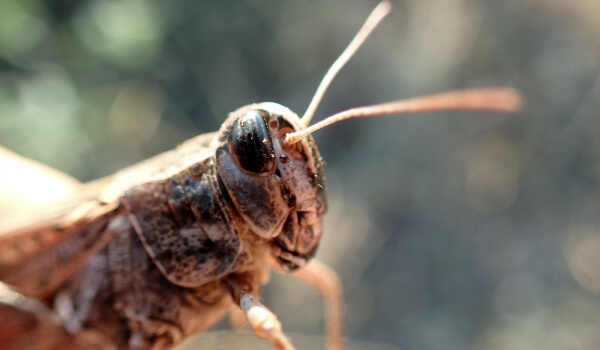
Photo: Cricket insect
All crickets are quite small in size, but still differ in their appearance depending on which group the insect belongs to.
Brownie cricket, up to approximately 24 mm in size. There are eyes on both sides. “On the head, the antennae are longer than their torso, which perform the function of touch.” The body is covered with a special substance called chitin. It helps the insect protect itself from harmful environmental factors and also prevents water loss.
Video: Cricket
Colors are grey-yellow, and the body itself has brown tints . They have wings that help them move at high speed. When folded, the wings protrude beyond the body itself, and resemble a long tail. Domestic crickets do not use their wings.
They have three pairs of limbs, the back pair is longer, so thanks to them the cricket can move quickly and over long distances. The front pairs of paws act as auditory organs. The back of the body is called the “ovipositor”. There are females and males, but they differ in size. In females, the ovipositor is longer — approximately 1 to 1.4 cm, in males 3 to 5 mm less.
The field cricket differs from the “home” cricket in its impressive size. The size of an adult is up to 2.5 cm. The body is black with brown hues, and covered with gloss. The head is oval with eyes and antennae. Otherwise, the “field bug” is similar to the brownie cricket.
The eastern trumpeter grows up to 1.3 cm. Compared to its counterparts, it is much smaller. The stem cricket got its name due to the fact that it lays eggs in the stems of plants themselves. Middle name — “Oriental trumpeter” received because of its origin (Far East).
The color is distinguished by its brown flowers, with shades of green. Also long antennae, 3 pairs of paws, the hind of which are the most powerful, wings and elytra are transparent. The elongated body is somewhat reminiscent of a grasshopper. Ant crickets are the smallest, up to 5 mm. They have no wings and resemble domestic cockroaches in appearance.
Where does the cricket live?
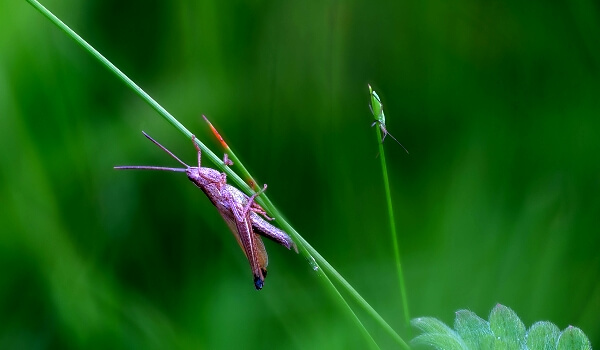
Photo: Cricket in the grass
Habitat « domestic” crickets areas with a warm climate in the summer months: green fields, meadows, open forest glades, pine groves under the sun. They dig a mink for themselves with their jaws, in which they later hide during bad weather or danger. When they leave their shelters, carefully covering it with grass, they go in search of food.
With the onset of cold weather, the domestic cricket seeks shelter in house extensions, and in any dwellings where there is heat. They do not live in apartments, except for the first floor of old houses. Field crickets live only in warm regions, in meadows, fields and forests. They dig minks for themselves in loose and oxygenated soil, with a depth of 15 to 25 cm. These minks are considered their shelter. During periods of cold weather, it hibernates as a larva and adult (in the adult stage).
Females can leave their minks in search of a partner, leaving him covered with a bunch of grass, but males will not leave their shelter. Rather, on the contrary, they protect him from his relatives, join the battle if necessary. It is not uncommon for field crickets to die for their “house”. For most of its existence, the field cricket lives on the surface of the soil.
The common stem cricket lives in the territories of the Far East, steppe Russia, southern Siberia, the Caucasus and Kazakhstan. Prefers to settle in the stems of plants, bushes, foothills. It waits out bad weather under the leaves on the ground.
Ant crickets live in the warm countries of America. They live near ant nests. And the cold periods from October to March are waiting in the anthills themselves in the stage of adults and larvae. This species can be found in Western and Eastern Europe, they were found in Russia and Ukraine, there are reports of findings in Italy and Romania.
What does a cricket eat?
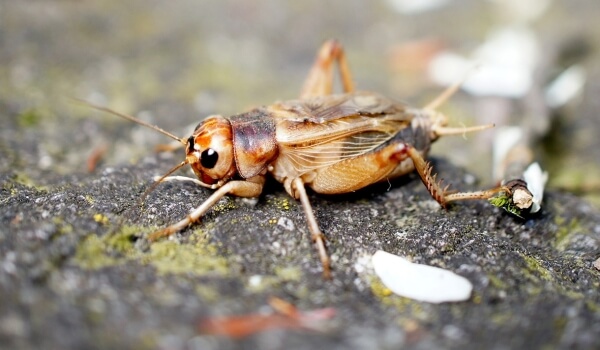
Photo: Cricket Insect
The diet of cricket is very diverse. In their nature, they all feed on plant foods: the roots and leaves of plants, fresh shoots of grass, leaves of shrubs. Young seedlings are preferred, especially adults. Field crickets are omnivores, and since they need protein in addition to plant foods, they also feed on small ground corpses of invertebrate insects.
House crickets also eat leftover food left by humans. But more preference is given to liquid food at home. Small invertebrates also eat soft and cadaveric tissues of insects. “Domestic insects have such a thing as cannibalism. Adults can eat young and larvae that have not yet reached sexual maturity.
Specially grown crickets are fed plant foods, always rich in proteins. The diet contains: the remains of fruits and vegetables, bread crumbs and other cereals, tops and leaves from the garden, as well as fish and egg flour. But most importantly, they need liquid, which is best given in the form of a water-soaked sponge. Such crickets are grown specially in the Moscow Zoo to feed their wards.
This is a harmless insect, they do not bite and do not show aggression towards the outside world and humans. All their hostility can manifest itself only to their rival, who has fallen into his protected territory. Therefore, you should not be afraid of it.
But there are times when, when crickets are overpopulated in the territory, the crop may be lost. This is more the exception than the rule, but there have been cases. And under certain weather conditions, the cricket can breed very quickly and “a lot”. Then special tools will come in handy as assistants to help get rid of uninvited guests.
Character and lifestyle features
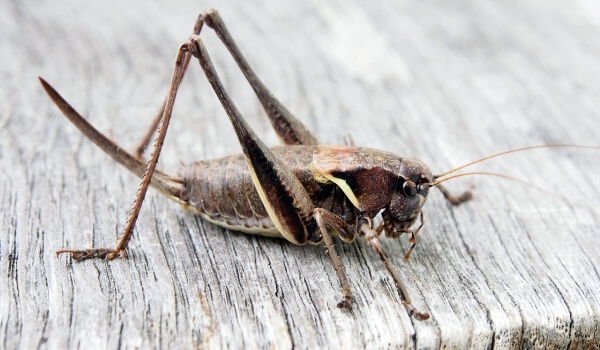
Photo: Cricket
The most striking feature that a cricket has, and for which a person sometimes breeds them “at home”, is melodic sounds. They emit unique, special and melodic signals. Moreover, such “melodies” are published exclusively by sexually mature males. There are three types of signals. Each sound has its own meaning. Some signals encourage the female to mate, while others scare off potential female boyfriends. And the third signals are emitted, caring for a partner in order to attract her.
How do crickets make sounds? On the right wing of the “bug” there are special chirping cords, they, in turn, rub against the left wing. This is how the chirping sound of a cricket occurs. And the raised wings serve as a resonator for sounds. Over 4,000 vibrations per second create their wings. Thus, the signals are very well audible to a person. All summer long, crickets chirp, and you can clearly hear it while being in nature.
“In the old days, it was believed that if a “voicing” cricket lives in the house, it brings good luck to the owner, protects him from evil and disease. For pregnant girls living in the house, this meant an easy birth. And you shouldn’t have gotten rid of them.” Today, everything is different, not many people like such “vocalists”, someone simply disdains insects, and someone is disturbed by such singing.
This insect loves warmth very much, without it, the process of reproduction and development slows down they become immobile. And if the temperature reaches minus numbers, the insect simply hibernates.
By the way, in some Asian countries, crickets are eaten, and it is considered a delicacy. Many visiting tourists are offered a taste of this insect on market tours.
Crickets have a special way of life – one male has a certain part of the territory that he controls. Can attract many females, whom he will consider only his own. Something like a harem. But God forbid another male gets into his territory – a fight will start in which only one individual will survive. And the victorious male can dine with his rival.
The Chinese, enjoying the way of life — rivalries between males, organize fights of field crickets. The cricket that wins the duel receives a “reward”.
Social Structure and Reproduction
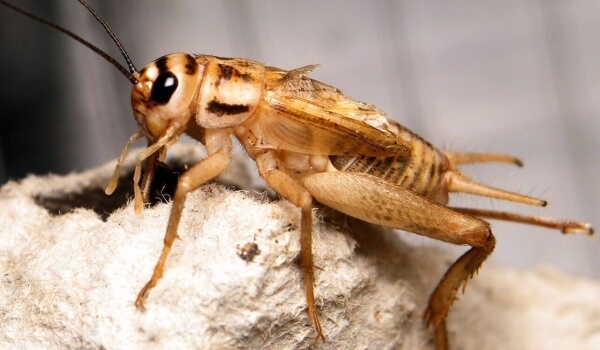 < p id=”caption-attachment-2340″ class=”wp-caption-text”>Photo: Field Cricket
< p id=”caption-attachment-2340″ class=”wp-caption-text”>Photo: Field Cricket
All insects go through three stages in their life cycle: egg, larva and adult (in other words, adults). But the very process of reproduction of crickets in each species differs in terms of development, the number of stages and life expectancy:
Field crickets – sing “serenades” at the entrance of their minks, calling for mating females. After the mating process, the females lay up to 600 eggs in the soil. The larvae appear after 2.5 – 4 weeks. This occurs at the very end of spring or early summer. After the emergence of larvae from eggs, they immediately molt, and become like wingless little bugs that can only crawl on the ground.
They grow very quickly, and during the whole summer they can shed up to 8 times. As soon as the cold comes, they hide in their minks dug by their jaws. In the houses, after 1 – 2 molts, they turn into an adult (imago). And as soon as they feel the arrival of warmth, they crawl out as adults, and again prepare for reproduction. After laying eggs, the female dies by the end of summer. The life span is up to 1.5 years.
The common cricket lays its eggs in moist cracks in the soil. One female can lay up to 180 eggs per season, but at high temperatures, from +28 and above, she can lay 2-3 times more. After a week and up to 3 months (depending on weather conditions – the warmer, the faster the appearance passes), nymphs hatch, also wingless. Pass 11 stages of their development to an adult. The duration of the “domestic” adult is up to 90 days.
The principle of mating and laying eggs of the stem cricket is similar to the previous methods described. Life expectancy is up to 3-4 months. Much depends on climatic conditions and the habitat of this species.
The cycle of laying eggs and until the full development of an adult ant cricket is 2 years. The longest of all. And the process itself consists of 5 stages, which takes place in anthills. Life expectancy is up to six months. “This species of crickets is not capable of singing, so mating takes place without courtship and long searches for “suitors”.
Natural enemies of crickets
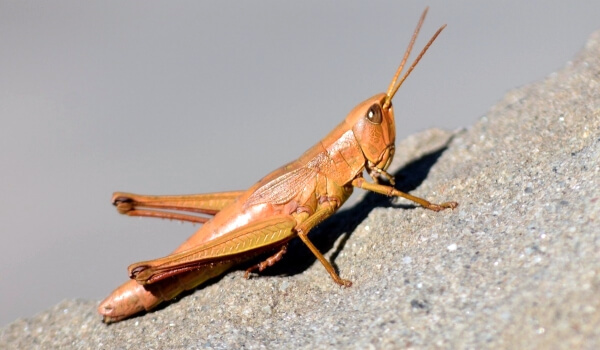
Photo: Cricket
Crickets don’t have many enemies. This is partly a man, since with a large overpopulation of insects, he will begin to fight them. Since no one wants to lose their crop, people start fighting crickets with the help of chemicals. This does not happen in our middle lane, because in order for a large number of them to breed, a tropical climate is needed, which we do not have.
Man uses cricket as bait to catch rare species of fish. But in some Asian countries they are eaten. In other countries, the insect is used as food for animals – reptiles that live in the house as pets. Since crickets are rich in protein and protein, they are considered a valuable product.
An interesting fact: in 2017, a newspaper reported on an American company in Texas that was the very first to produce fried snacks consisting of crickets with five flavors: sea salt, barbecue, sour cream and onion, etc. Snacks were then positioned as protein and protein foods.
Population and species status
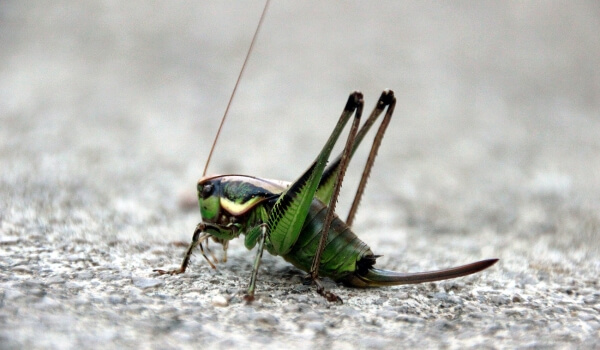
Photo: Stem cricket
There are a little more than 2 thousand different types of crickets on our planet. They live on all continents where there is warm sunny weather, moist soil and vegetation. Naturally, in countries where the air temperature is below zero, it will obviously not be possible to meet a “chirring” insect.
A person has successfully learned to breed these insects at home. In order for the cycle to be continuous, a number of conditions must be met: temperature and population density in the container. But the fact that a dangerous disease has appeared in the cricket population is caused by microsporidia “Nosema grylli”.
In a very short time, the entire population of insects located in the same room (habitat, containers, etc.) can die. Crickets become lethargic, swell and die. To combat the disease, drugs are used that are used to treat nosematosis in families with bees.
Cannibalism, prolonged molting, and softening of their skin – chitin can also contribute to a reduction in the population. With cannibalism, it is understandable, but a long molt contributes to damage to the larvae at a high density of individuals in the occupied area. Chitin is responsible for the external impact of natural factors on an adult, respectively, any damage to it increases the risk of insect death.
Many people know this amazing “vocalist”. He lives side by side with a man and is completely harmless. The cricket is one of the interesting creatures that can coexist in harmony with nature. Therefore, you should not offend him if you suddenly meet on your way. It is enough to listen to what he “sings” about and the mood will probably rise by itself!

